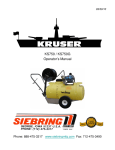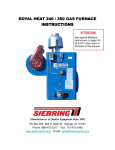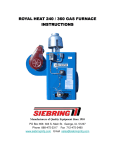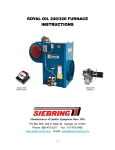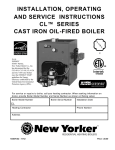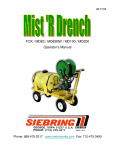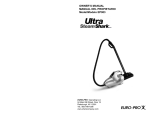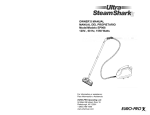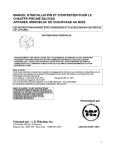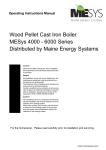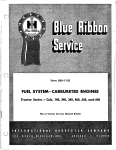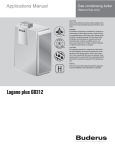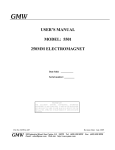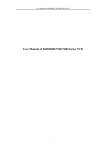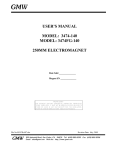Download PRESSURE WASHERS INSTRUCTIONS
Transcript
PRESSURE WASHERS INSTRUCTIONS Manufacturers of Quality Equipment Since 1910 PO Box 658 303 S. Main St. George, IA. 51237 Phone 888-475-3317 Fax 712-475-3490 www.siebringmfg.com Email [email protected] TABLE OF CONTENTS 1. TABLE OF CONTENTS 2. 3. INTRODUCTION OPERATOR SAFETY 4. 5. PERSONAL SAFETY GENERAL SAFETY 6. 7. GENERAL OPERATING INSTRUCTIONS TEMP CONTROL / DEMA INJECTOR 8. 9. FLOW SWITCH FLOW CONTROL 10. THERMOSTAT 11. PRESSURE SENSITIVE REGULATING UNLOADER – HOW IT WORKS 12. 13. 14. 15. 16. 17. 18. 19. 20. 21. 22. 23. PRESSURE SENSITIVE REGULATING UNLOADER – SPRAY MODE PRESSURE SENSITIVE REGULATING UNLOADER – BYPASS MDOE UNLOADER – DECRIPTION & TROUBLESHOOTING UNLOADER – GOLDEN EAGLE 7100 UNLOADER – CAT 7500S UNLOADER – CAT 7534 UNLOADER – CAT 7600S UNLOADER – CAT 7672 NOZZLES AND TIPS TROUBLESHOOTING INDEX TROUBLESHOOTING CONTINUED TROUBLESHOOTING CONTINUED 24. TROUBLESHOOTING CONTINUED 25. TROUBLESHOOTING CONTINUED 26. TROUBLESHOOTING CONTINUED 27. TROUBLESHOOTING CONTINUED 28. TROUBLESHOOTING / DELIMING 29. WINTERIZING (CAT BULLETIN 083) 30. WIRE SIZE / LINE LOSS 31. PARTS INDEX 32. PARTS CONTINUED 33. PARTS CONTINUED 34. CWG 704 (BEECH) PARTS 35. WIRING DIAGRAM (HDD 3004) 36 – 38 LABELS – CAUTIONS & WARNINGS 1 SIEBRING PRESSURE WASHERS INTRODUCTION The general misunderstanding of a steam cleaner and hot pressure washer should be understood. The first generation of hot, low pressure cleaning was the steam cleaner – one to two gallons of water heated 300°- 500°F. were discharged against dirt at 100 – 125 PSI. As the water left the nozzle, the pressure drop caused the water temperature to drop to 212° and much of the water temperature dissipated into the air as water vapor. Dirt and grease were melted and dripped off of the object being washed. The second generation of hot cleaning now uses 600 – 1200 PSI high pressure at 100°200°F. water temperature. 1.5 to 5.0 GPM are discharged against the dirt. The unvaporized hot water strikes the dirt, cutting sticky and stubborn dirt with kinetic energy and thermal action. Siebring Manufacturing has been in the business since 1910. Siebring was involved in the first generation of steam cleaning equipment and has continually worked in the development of and rugged hot, high pressure washers. In the mid sixties, Siebring was again was on the ground floor with new developments, incorporating new designs, higher pressure pump applications and the like. GENERAL APPLICATIONS Greases with heavy wax bases, animal oils in animal waste and dirt and grime are targets for this equipment. Engine and transmission rebuilding, heavy equipment in farm, construction, excavation and industry are applications for easy cleaning in short periods of time. Building, preparation for painting, special shop maintenance, cleaning animal confinements, meat processing, chemical and petroleum industries all favor hot, high pressure cleaning. Construction and industrial equipment repair preparation normally requires hot pressure washing. A newer, specialized use for this equipment is to heat and apply de-icing and anti-icing solutions for the aircraft industry. The same equipment is used for air frame and power plant cleaning. Road film – Unfortunately, road film is untouched by hot or cold pressure washing. It must be physically contacted to break the static bond causing road film cleaning problems. 2 OPERATOR SAFETY INSTRUCTIONS DANGER! DO NOT ATTEMPT TO INSTALL OR OPERATE THIS MACHINE UNTIL YOU HAVE READ THIS MANUAL. IF YOU OR YOUR OPERATOR CANNOT READ ENGLISH, HAVE THIS MANUAL EXPLAINED FULLY BEFORE ATTEMPTING TO OPERATE THIS EQUIPMENT. DANGER! (Electric Models) THIS MACHINE MUST BE PROPERLY GROUNDED TO AVOID FATAL ELECTRICAL SHOCK IN THE EVENT THAT IT BECOMES ACCIDENTALLY GROUNDED. HAVE ELECTRICAL CONNECTIONS MADE BY A QUALIFIED ELECTRICIAN. WARNING! (Electric Models) DISCONNECT THIS MACHINE FROM ELECTRICAL SOURCE BEFORE MAKING ANY REPAIRS. WARNING! THIS MACHINE IS DESIGNED TO PRODUCE VERY HIGH PRESSURE AND TEMPERATURE AT THE GUN TIP. TO PREVENT INJURY OR DAMAGE, HOLD CLEANING GUN SECURELY AT ALL TIMES WHEN PUMP IS IN OPERATION AND FLUID IS BEING SPRAYED. CAUTION! CHECK CLEANING EQUIPMENT, REMOTE HOSE, GUN, WAND AND FITTINGS PRIOR TO OPERATION. DO NOT OPERATE THIS MACHINE WITH A DAMAGED OR WORN HOSE, LEAKS, OR WITH ANY COVERS OFF THAT WOULD EXPOSE BELTS, PULLEYS OR ELECTRICAL DEVICES OR CONNECTIONS. DANGER! TAMPERING WITH THE MACHINE’S FACTORY PRESET UNLOADER VALVE SETTINGS AND/OR THE PRESSURE RELIEF VALVE SETTING COULD RESULT IN A MACHINE EXPLOSION. DO NOT ATTEMPT TO CHANGE THE SETTINGS. DISCONTINUE USE IF A MALFUNCTION OCCURS AND CONTACT YOUR LOCAL AUTHORIZED DISTRIBUTOR. DANGER DO NOT OPERATE THE UNIT WITH A MALFUNCTIONING BURNER OR BURNER CONTROLS. INSPECT BURNER AND BURNER CONTROL OPERATION BEFORE EACH USE. IF YOU SUSPECT A PROBLEM WITH THE BURNER, DISCONTINUE USE IMMEDIATELY AND INVESTIGATE. DANGER DO NOT POINT GUN AT PEOPLE OR ANIMALS! RESULTS COULD BE FATAL! HIGH PRESSURE WATER DAMAGES THE SKIN AND CAN INJECT WATER INTO THE BODY. DANGER DO NOT REFUEL ENGINE SUPPLY TANK OR BURNER SUPPLY TANK WHILE UNIT IS RUNNING OR HOT, ALLOW UNIT TO COOL PRIOR TO REFUELING. 3 PERSONAL SAFETY -Wear safety glasses at all times when working on pumps. -Wear a face shield and proper protective gear when pumping hazardous chemicals. -Keep the work area clean, uncluttered and properly lighted. Secure and stow all unused tools and equipment. -Keep visitors at a safe distance form work area. -Make the workplace child proof with padlocks, master switches and by removing starter keys. Washer Dangerous, Safety Panel Warns…CPSC document 5069 The U.S. Consumer Product Safety Commission has issued a warning to consumers who use electrically powered pressure washers for cleaning milk tanks, spray tanks and other farm equipment. According to a federal safety alert, consumers can receive a fatal electrical shock from pressure washers if the power cord connections become wet or an internal short exists. Since the pressure washers are used to spray water, the power cord, washer and consumer are often wet, and this can be fatal, especially if the machine is not properly grounded, the report explained. Consumers should not use adapter plugs to connect the three-wire plug to a two-prong household receptacle without properly grounding the adaptor plug. Power cord connections should never be allowed to lie in water. The commission urges these precautions: Always plug a 3-wire grounded pressure washer into a properly grounded receptacle. If possible, use a receptacle protected by a Ground Fault Circuit Interrupter (GFCI). If an extension cord must be used, use a heavy-duty, 3-wire properly grounded and properly sized for the equipment being used. Keep the cord connection out of the water and away from the item being washed. Wear rubber-soled footwear when operating the washer. Never cut or splice the power cord or extension cords. Never remove the grounding plug from the power cord. Never operate the washer after it has tripped the GFCI or circuit breaker without first having it examined by a competent repair person. Never allow children to operate a pressure washer and keep children away form the washer when an adult is using it. For more information, consumers can call the UNITED STATES CONSUMER PRODUCT SAFETY COMMISSION hotline, 800-638-CPSC (800-638-2772). 4 GENERAL SAFETY 1. A safety pressure relief device is installed at the factory. Removal of this device could void the unit warranty and cause injury to personnel. 2. WARNING – Do not pump flammable or explosive fluids such as gasoline, fuel oil, kerosene, etc. Do not use in explosive atmospheres. The pump should only be used with liquids compatible with the pump component materials. Failure to follow this warning can result in personal injury and/or property damage and will void the product warranty. 3. Do not run the pump faster than maximum recommended speed. 4. Do not attempt to pump at pressures higher than rated. 5. Maximum liquid temperature is 140°. 6. Make certain that the power source conforms with the requirements of your equipment. 7. Do not operate machine with belt guard, shaft guard or similar safety devices removed. 8. Disconnect power, stop engine and burner prior to servicing. 9. Relieve system pressure prior to servicing. 10. Drain all liquids from system before servicing. 11. Secure discharge lines and guns before starting the pump. An unsecured line may whip around under pressure causing personal injury and/or property damage. 12. Check hoses for weak or worn conditions before each use. Make certain that all connections are tight and secure. 13. Periodically inspect the pump and system components. Perform routine maintenance as required. See maintenance section in this manual, CAT pump Service Manual and Honda manual as applicable. 14. Electric motors must be adequately grounded. 15. Do not operate a gasoline engine in an enclosed area. Be sure the area is well ventilated. 16. Gasoline is a highly combustible fuel. The improper use, storage or handling of gasoline can be dangerous. Never fill or touch a hot engine. 17. Do not handle a pump or motor with wet hands or when standing on a wet or damp surface. 18. Use only pipe, hose and fittings rated for the maximum P.S.I.G. rating of the pump. If an unloader is used, pipe, hose and fittings rated for the pressure at which the unloader relieves itself. 5 General Operating Instructions 1. Check Oil Level (See Honda gas engine Owner’s Manual for additional information). 2. Check CAT pump oil level. Oil level must be up to the red center dot (see CAT Service Manual). 3. Connect pressure water supply hose or immerse suction hose in adequate clean water supply. Be sure screen is in place. 4. Connect electrical power A. Burner 120VAC B. Pump Motor 220VAC (specified phase) 5. Check engine fuel supply if applicable. 6. Hot washer - check burner fuel tank for adequate fuel supply (#1 or #2 Heating Oil). Do not use kerosene or bio-diesel. 7. Installed on each washer is a square soap container box that will accept a one gallon jug. Most products need to be diluted prior to use. Powered soaps are unacceptable. WARNING: Secure gun and lance prior to starting the pump. CAUTION: Momentarily open the gun valve to relieve pressure prior to starting the pump motor or engine. 8. Start the pump motor. 9. Hot washer – Ignite burner with control switch (see Beckett AFG manual for additional burner information). 10. Soap (Dema) injector – Adjust metering screws for adequate flow (see page 7 for additional info). 11. Temperature controller/thermostat – Adjust water temperature to desired operating level. 12. Check pump operating pressure. Do not exceed manufacturer’s recommended pressure. Begin cleaning. 6 TEMPERATURE CONTROL – 430027 Adjust temperature control to the desired temperature. TEMPERATURE CONTROL HOT COLD Typical Wiring To Flow Switch To Control Switch OPERATION – DEMA INJECTOR 203B / 204B Warning: Use care when handling hazardous chemicals. Warning: Setting the water bypass screw too far in could starve and damage the pump. See figure below for location of water bypass screw and fine metering adjustment screw. Turn on water supply valve. The injector may draw momentarily as the system is filling but normally will stop as the system builds up to full pressure. To actuate injector, turn the bypass screw clockwise until product begins to be drawn from the container. After the fluid reaches the injector, the feed rate may be adjusted to the desired rate by turning the bypass screw. For low injection rates, it is advisable to set the bypass screw for more injection than required; then turn the fine metering screw clockwise to reduce injection to the desired rate. If the injector will not draw with the bypass screw full in, then the water flow is below the range of the injector. If the injector draws with the screw full out but pressure loss is excessive, then flow is above the range of the injector. Fine Metering Adjustment Screw Water By-pass Screw 7 Gems (Thomas Products) FS-925 Flow Switch Hermetically sealed SPDT switch No.18 AWG Leads Spring Permanent Magnet Piston Operating Principle - A magnet-equipped piston, displaced by the pressure differential from fluid flow, magnetically actuates a hermetically sealed, SPDT reed switch within the unit. The switch is factory set and must not to be adjusted in the field. This switch, in turn, operates a remote relay, providing system control. The piston metering land diameter precisely sets the actuation point by regulating by-pass clearance. Spring return of the piston is positive as flow decreases. Do not remove the non-metallic spacer from between the metal base and flow switch, magnetic interference could result. Repair Procedure - Magnet and plunger are molded as a unit. Cracks and deformation may occur with time. Replacement parts are available. Rough spots on the plunger and swollen plastic can be dressed down for smooth operation with a fine metal file or emery cloth (180 grit or finer). A thin coat of Vaseline will lubricate the plunger for smooth operation. Special adjustments are required for proper installation of the SPDT reed switch. Do not remove this unit from the brass body of the switch without factory instructions. GEMS LOAD-PAK FLOW SWITCH SWITCH LOAD VARISTOR (M.O.V.) LOAD Typical Wiring Maintenance – Accumulation of foreign debris should periodically be removed from these switches. Occasional “wipe-down” cleaning when excessive contamination is present is all that is normally required. To clean: Remove unit from system and disassemble as shown (left). Clean all parts, reassemble and reinstall unit. 8 Johnson Controls Flow Control Model F61KD-3C / F61KD-4C Operation – The flow switch responds to pressure exerted on the fluid paddle by the flowing fluid. During normal operation, the circuit between the red and yellow leads (terminals) closes when sufficient fluid flows through the piping to trip the flow switch. When a “no flow” condition exists, the switch opens, breaking the circuit and shutting down the burner. Typical Wiring Siebring Hot Washers ! CAUTION To power source ! Not used To thermostat or burner WARNING Risk of Improper Operation Risk of Electrical Shock The switch is set near the minimum flow rate. Do not set lower than factory setting as this may result in the switch failing to return to a “no flow” position. Disconnect power before making any electrical connections. Failure to follow this precaution may result in equipment damage, electrical shock of death Troubleshooting: - Switch does not activate Possible debris caught within switch mechanism. Clean mechanism, test switch operation several times to ensure proper operation. - Control switch action is reversed Has flow switch been changed? Ensure connections match wiring diagram. -Switch fails to return to “no flow” position Stuck flow gate – clean to free up movement Switch setting has been set lower than factory setting. Increase setting. - Control does not switch on flow increase Low water pressure. Check for cracked/broken paddle. Replace if necessary. Internal damage form freezing conditions may require switch replacement. - Switch failure is suspect. The following check is for troubleshooting only! Jumper across red / yellow terminal and check for machine operation. If machine operates normally, replace switch. Remove jumper. Repairs and replacement – Field repairs, except for the replacement of the cover can not be made. Contact Siebring Manufacturing for replacement flow switch. 9 Honeywell Aquastat Controller L4006A Copper Capillary Tube (to sensing bulb) Differential Adjustment Wheel 5 Wire Terminal Screws Set-point Indicating Dial Operation - L4006A breaks the circuit on a temperature rise to the control setting. High limit controller: Shuts off burner when water temperature exceeds high limit setting. Burner restarts when temperature drops to high limit setting. Low limit controller: Maintains minimum water temperature. Turns burner on at temperature setting, less differential. Differential Adjustment wheel, typically used on boiler applications. Factory set to 5°. Checkout - Check to make certain that the Aquastat Controller has been installed and adjusted properly. Put the system into operation and observe the action of the device through several cycles to make certain that it provides proper control of the system as described in the Operations section. Further adjustments can be made as required. Typical Wiring To Burner 5 To Switch L4006A Flow Control 10 Pressure Sensitive Regulating Unloader This type of unloader may be referred to as a “Trapped Pressure” type or just "Pressure" type. This type of valve opens to bypass when it senses the pressure build up of the pump output having nowhere to go. The main characteristic of this most commonly used valve is how it traps the pressure in the hose when the trigger of the pressure gun is released and unloading excess pressure between the pump & unloader. The disadvantage of this type of valve is the spike of pressure felt by the operator and sprayer/pressure washer components when the trigger is again squeezed. This creates a "kickback" effect on the gun/wand so be careful when using ladders or other types of access equipment. When your system uses a trigger gun that stops the water flow from the pressure pump the unloader valve must be employed. Understand that when the trigger of the gun is released the water flow to the nozzle is interrupted. The power source and the pressure pump are still running, Without some pressure washer system safety device the water would have nowhere to go, building pressure till disaster ensued. Enter the Unloader Valve. The most basic function of the unloader is to act as a "traffic cop" to the water flow in your system as soon as it senses "pressure build". When the “Pressure Build” condition is met the unloader will then actuate the piston assembly to divert the water flow toward the bypass port. When this is occurring the pump is said to be in "bypass mode" and the unloader valve is said to be "cycling". This scenario ends when the trigger is squeezed alerting the unloader valve to redirect the flow to the gun and high pressure nozzle once again. While this may seem to be problem solved it is not without risks. When the water flow is in bypass mode, new cool water is not entering the system. The moving parts in the pump are creating friction which produces heat that is transferred to the water flow in the bypass loop. Since a limited amount of water is in bypass this transfer of heat can occur quickly. If the pump has been in the bypass mode long enough to build an excessive amount of heat, thermal shock may occur if cold water is suddenly introduced into the system. Most pumps are designed to handle water temperatures of 160° F. When the water in bypass climbs above 160°F damage to the pump will begin. Damage can occur to the pump packings, plungers and seals and even to the short bypass hose in external bypass setups. It is a good idea not to leave a pump in bypass mode for more than 2-3 minutes, by simply squeezing the trigger gun you will introduce new cool water into the system. 11 Pressure Sensitive Regulating Unloader Spray Mode Gun trigger is depressed with gun in use. Pump flow enters from the left of the diagram (inlet port), passes through the unloader, out of the outlet port, to the gun. Inlet Port Pump Piston Assembly CAUTION: A minimum bypass of 5 10% of the UNLOADER RATED FLOW CAPACITY is required for proper unloader performance. Outlet Port Check Valve Flow Additional bypass fluid may be the excess pressure - the difference between the pump output and the unloader setting. Bypass Port 5 - 10 % Min. Bypass 12 To Gun CAUTION: If the entire output is directed through the unloader (zero by-pass) the cushioning feature of the by-pass liquid is eliminated and the unloader can malfunction and wear prematurely. Pressure Sensitive Regulating Unloader Bypass Mode WARNING: DO NOT OPERATE IN BYPASS MODE LONGER THAN 2 MINUTES. Pump CAUTION: A minimum bypass of 5 10% of the UNLOADER RATED FLOW CAPACITY is required for proper unloader performance. Piston Assembly Inlet Port Gun trigger valve is closed, gun is not in use. Pump flow enters from the left of the diagram (inlet port), dead ends against output check valve, overcomes the spring pressure holding the piston assembly and is forced down through the bypass port. Outlet Port Check Valve Flow To Gun CAUTION: If the entire output is directed through the unloader (zero by-pass) the cushioning feature of the by-pass liquid is eliminated and the unloader can malfunction and wear prematurely. Bypass Port Bypass 13 Adjustable Pressure Regulating Unloader The following Unloader models are used on Siebring Pressure Washer applications: Cat Pump model 7500, 7534, 7600 & 7672. J.E. Adams Golden Eagle model 7100. Operation – The unloader holds established system pressure in the discharge line when the trigger gun is closed, solenoid valve is closed (gate) valve is closed or the nozzle is clogged, bypassing the unrequired flow between the pump and the unloader. It returns to established system pressure without delay upon squeezing the trigger gun or opening the solenoid (gate) valve. When properly set the unloader protects the pump from pressure extremes associated with obstructions in the discharge line, while maintaining the established system pressure. When no flow is required by the system, the unloader by-passes all the system flow and relieves the load on the pump. Pressure is held in the discharge line (between the unloader and the gun) ready for a quick return to high pressure operation. Note: A minimum bypass of 5-10% is necessary for the unloader to operate properly. CAUTION – If the entire output is directed through the unloader (zero by-pass) the “cushioning” feature of the by-pass liquid is eliminated and the unloader can malfunction or wear prematurely. Do not leave the unit running in by-pass mode for extended periods of time. Overheating of the pump manifold could result. Problem Solution Unloader Cycles Check for leak downstream of unloader Worn o-ring or check valve Air in system, poor connection O-ring in gun worn Liquid leaking from bottom fitting O-ring for fitting cut or worn O-ring for seat cut or worn Liquid leaking form middle O-ring for piston cut or worn O-rings for piston stem cut or worn Unloader will not come up to pressure Not properly sized for system pressure Foreign material in unloader. Clean filter. Piston stem o-rings worn Nozzle worn Insufficient flow to pump Extreme pressure spikes Adjusting nut turn completely into unloader Restricted by-pass or no by-pass System flow exceeds unloader rating 14 GOLDEN EAGLE 7100 UNLOADER 800 - 2000 PSI 15 16 17 18 19 IMPORTANT PARTS FOR SIEBRING WASHERS Model P.S.I. G.P.M. TIP / NOZZLE DEMA INJECTOR CWH704 700 4.0 9 TIP 204B CDD1003 / CWH103 1000 3.0 6 TIP 203B CDD1204 1200 4.0 7 NOZZLE 204B CDD1503 1500 3.0 6 NOZZLE 203B CDD2004 / CW2004 2000 4.0 5 NOZZLE 204B HDD1003 / HHP180 1000 3.0 6 NOZZLE 203B HDD1204 / HHP1204 1200 4.0 7 NOZZLE 204B HDD1503 / HHP1503 1500 3.0 4.5 NOZZLE 204B HDD2004 / HHP2004 2000 4.0 5 NOZZLE 204B GAHP180 1000 3.0 6 NOZZLE 204B (OPT.) MWG180 1000 3.0 6 NOZZLE 204B (OPT.) MWG1204 1200 4.0 7 NOZZLE 204B (OPT.) MWG2004 2000 4.0 5 NOZZLE 204B (OPT.) 5 10 3 1 2 8 4 7 6 1. 2. 3. 4. 5. Typical Installation, Cold Pressure Washer Hose Quick Coupler (female) Unloader CAT Pump CAT Pump Manifold Pressure Gauge 9 6. By-pass Hose 7. Solution Injector 8. Garden Hose connector w/screen 9. ⅜” Hose 10. Connector plug (male) 20 TROUBLESHOOTING INDEX A. PRESSURE DROP (NEW INSTALLATION) B. PRESSURE DROP AFTER MACHINE IS IN SERVICE C. PULSATION IN HOSE D. UNLOADER CYCLES RAPIDLY E. FLOW SWITCH FAILS F. MOTOR STOPS AFTER SHORT DURATION G. PUMP MOTOR FAILS TO START H. PUMP MOTOR FAILS TO STOP I. AUTOMATIC PUMP AND BURNER SHUT DOWN SYSTEM J. BURNER MOTOR FAILS TO START K. BURNER MOTOR FAILS TO STOP L. BURNER FAILS TO IGNITE M. INTERMITTENT FLAME N. WATER LEAKING FROM HEATING COIL COMPARTMENT O. PRESSURE FAILS TO DROP WHEN GUN VALVE IS CLOSED P. LIQUID IN GAUGE Q. PUMP OIL DISCOLORATION R. WATER OR OIL LEAKING FROM BOTTOM OF PUMP S. SOLUTION INJECTOR FAILURE T. WATER SUPPLY AND CONTAMINATION U. LEAKING RELIEF VALVE V. FREEZING OF PUMPS AND COILS 21 TROUBLESHOOTING A. PRESSURE DROP (new installation) 1. Inadequate water supply. Adjust water regulator on intake (turn screw downward). Increase water supply to 30 P.S.I. minimum. 2. Improper nozzle size. Consult manufacturer. 3. Open solution injector. Close injector solution supply valve when not in use. B. PRESSURE DROP AFTER MACHINE IS IN SERVICE 1 Unloader cup or wall scored or worn. Install a rebuild kit or replace unloader. 2. Pump piston cup worn. Install rebuild kit. 3. Damaged piston cylinders. Install water sand filter. 4. Worn nozzle. Replace with correct or same size nozzle. 5. Air leak to solution injector. Close solution injector supply valve or replace hose. 6. Loose pump drive belt (if applicable). Adjust tension to achieve ½” movement of belt at mid-point. 7. C. Clogged pick-up in tank. Clear clog. PULSATION IN HOSE (usually accompanied by a drop in pressure). 1. Open solution injector. Close solution injector supply valve or fill solution tank. 2. Water supply shortage or clogged pick-up in tank. Increase pump water supply, clear clogged pick-up.. Clean filter inside pressure regulator or screen in intake connection. 3. Defective piston cup. Replace piston cups. 4. Stuck unloader piston 5. Obstruction in nozzle causing “false” unloader functions. 22 TROUBLESHOOTING D. (CONTINUED) UNLOADER CYCLES RAPIDLY 1. Rapid in-out movement of unloader plunger (units without complete shutoff). Leak in high pressure line, gun leak, or a “weep” type gun is in use. Defective poppet (nylon plunger in in lower portion of unloader). Poppet may be deformed or sticking. Replace or dress smooth with fine emery cloth. Bad unloader cup, seals or o-rings – replace. Scored unloader cup bore – replace unloader. Plugged nozzle – clean/replace nozzle. E. FLOW SWITCH FAILS 1. Burner fails to start/stop when gun is shut off/on (mobile wash and partial shut off models). The swing gate (paddle) located in the water stream is stuck, loose or clogged with debris. Remove and clean. Replace if defective. F. MOTOR STOPS AFTER SHORT DURATION 1. Thermal Overload tripped. Check for low voltage, excessive drive belt tension, extension cord not adequate gauge for length or stuck starter switch. 2. Excessive operating pressure. Reduce pump operating pressure to manufacturers recommendation. 3. Defective motor start switch (inside of motor) or motor fails to reach operating speed & pressure. Have an electrician verify motor condition. G. PUMP MOTOR FAILS TO START 1. No Power. Check plugs, fuses and cords for contact. 2. Defective flow switch (complete shut-off models). Free the magnetic plunger within the flow switch. Remove plunger and coat with Vaseline. 3. Thermal overload on motor tripped out (if so equipped). Check for low voltage on power supply, extension cord not adequate gauge for length, check belt for excessive tension, and check pump for excessive pressure. 4. Defective load pak. Try manual override switch on electrical connection box. 5. Excessive pressure in discharge hose. Open gun valve, check unloader. 23 TROUBLESHOOTING H. (CONTINUED) PUMP MOTOR FAILS TO STOP 1. Flow switch on “complete shut-off units” plunger sticks. Free the magnetic plunger within the flow switch. Remove plunger and coat with Vaseline. Check for ½” non-metallic spacer in place between mounting area and switch body (see page 8 for more info.). 2. Air in coil or air in piping of facility. Remove air cushion from unit, service lines and water supply (bleed air from system). 3. Defective operating switch. Check for welded motor starter contacts or line switch. I. AUTOMATIC PUMP AND BURNER SHUT DOWN SYSTEM 1. Unit fails to stop when gun is closed (shut). Check for leaks in system and repair if required. Disconnect wires from “switch” terminals on load pak in electrical box. If unit stops, inspect flow switch for foreign material on piston. If piston is free, switch is defective or improperly adjusted. If unit continues to run, disconnect wires from “load” terminals on load pak in electrical box. If unit stops, load pak is defective. If unit continues to run, motor starter is defective. Stuck plunger on flow switch – remove burrs and residue with fine emery cloth. Coat plunger with Vaseline and reinstall. 2. Unit will not stop when gun is closed. Be sure there is no electrical power to the unit and no fuses are blown. Check to be sure the overload is not tripped. If tripped, press reset button. Make sure water supply is on and is sufficient (30 P.S.I. minimum). Check for kinked feed hose. Use an insulated jumper wire and momentarily jumper the “switch” terminals on load pak (electrical box). See item 1 above. If unit is being used on a pipe line system, delayed starting can be caused by air in the piping. Pipe must be completely full of water. Check for dirt or foreign matter in the filter or screens preventing adequate water flow through the flow switch. 24 TROUBLESHOOTING J. (CONTINUED) BURNER MOTOR FAILS TO START 1. Check burner switch on side of burner. Up is “on” may be defective 2. Water temperature control stuck “open.” Jumper wire terminals on temp switch momentarily. If burner starts, replace temperature switch. 3. Defective flow switch. Jumper wire terminals on flow switch momentarily. If burner starts, replace flow switch. 4. Overload button tripped on burner motor. Depress button to reset. If problem continues, consult electrician. K. BURNER MOTOR FAILS TO STOP 1. Check burner switch. Down is “off” may be defective. 2. Water temperature control stuck “closed.” Disconnect one wire of the temperature control switch to see if control is the problem. L. BURNER FAILS TO IGNITE 1. Empty or low fuel supply. Replenish fuel supply. 2. Plugged filter or nozzle. Replace filter cartridge and appropriate nozzle. 3. Air leaks or air in oil line. Bleed pump. Check oil line fittings for air leaks. 4. Weak ignitor/transformer. With an insulated screwdriver, draw a spark across the ignitors, spark should be ¾” to 1”. At ½” replace ignitor transformer. 25 TROUBLESHOOTING M. (CONTINUED) INTERMITTENT FLAME 1. Dirty oil supply, water in fuel tank. Check filter and nozzle for cleanliness. Clear tank and filter of water. 2. Low oil supply Raise fuel level in supply tank. Oil line cracks and/or loose connections. Tighten or replace parts to prevent air bubbles (suction leaks) in oil line. N. WATER LEAKING FROM HEATING COIL COMPARTMENT 1. Drips Condensation drips (several per minute) are normal. 2. Steady stream leak. Cracked coil, needs repair or replacement. O. PRESSURE FAILS TO DROP WHEN GUN VALVE IS CLOSED 1. Defective unloading valve. Clean or replace. 2. Leak in gun, fittings, hose or coil under high pressure. Repair leak. P. LIQUID IN GAUGE 1. Gauge is liquid type, oil is normal. Replace gauge if empty or low on oil. 2. Water leaking from gauge. Ruptured mechanism (Bourdon tube). Replace gauge assembly. Q. PUMP OIL DISCOLORATION 1. White foam – water in oil. Drain and replace with CAT pump oil or temporarily with S.A.E. 40 nondetergent motor oil. Faulty intake seals from wear or freezing – replace as required. 2. Brown foam – rust & water. Pump may need rebuilding if pressure is dropping and a rapid reoccurrence of foam in sight glass after several hours of operation with fresh oil. 26 TROUBLESHOOTING R. (CONTINUED) WATER OR OIL LEAKING FROM BOTTOM OF PUMP 1. Water – noticeable amounts. Inlet water seals on pistons failing. See appropriate pump manual. Cracked pump manifold from freezing – replace. 2. Oil – noticeable amounts. Leak and failure of oil seals on pistons. Return to Siebrings for repair (notify to verify condition). S. SOLUTION INJECTOR FAILURE 1. Improper water supply to pump. Turn water bypass screw counter clockwise. This will decrease the solution draw, increasing the water supply to the pump. 2. Improper metering screw adjustment. Metering screw turns left to increase solution flow. Do not exceed 5 turns form full closed position. Try to achieve flow of ½” per second for most thick detergents passing through the plastic solution feed tube. 3. Plugged strainer on solution tank. Dirty screen in tank filter assembly, or undissolved powdered soap. 4. Water back feeding to solution supply tank through injector. Dirty, deformed or missing check ball in injector metering assembly. Weak ball check spring. Bad washer on ball seat in intake on injector. T. WATER SUPPLY AND CONTAMINATION 1. Sand from private wells. Allow water sample to stand in clear glass bottle over night to observe sediment. Add line filter if in doubt. 2. High sulphur. Brass parts may need replacement when used in high concentrations of sulphur. 3. Hard water On hot washers, if water tests to 90 grains of hardness or above, use of a water softener is required for improved coil life and prolonging the time between cleaning and/or de-liming. 27 U. LEAKING RELIEF VALVE 1. Foreign matter may be caught in the valve seat. Remove from machine, disassemble. Soak in vinegar overnight. V. FREEZING OF PUMPS AND COILS 1. Water frozen in pumps and coils will void warranty. Winterizing mix = 50/50 mix of water and anti-freeze or 50/50 mix of water and methanol (see winterizing steps on page 26 of this manual). If freezing conditions are suspect, always intake approximately 1 gallon of winterizing mix or until mix is expelled for gun discharge. In hot units, blow through unit coils with compressed air to avoid freezing (large replacement cost). DELIMING INSTRUCTIONS FOR HOT WATER COIL CAUTION: Do not use this procedure on a coil that is completely plugged. For severe cases, call Siebring Manufacturing. 1. 2. Disconnect the steam hose at the unit. In a plastic container, put 2 ½ gallons of water and into this very slowly add one gallon of muriatic acid. CAUTION: ALWAYS ADD THE ACID TO THE WATER, NEVER THE WATER INTO THE ACID 3. 4. 5. 6. 7. 8. Take a short piece of garden hose with a male garden hose fitting on one end. Put one gallon of clear water in another container for use later Start pump and connect this short hose to the water inlet fitting and suck in the acid solution. Immediately suck in the one gallon of clear water to flush the acid out of the pump only. Let the unit stand for 10 – 15 minutes – no longer. Connect the regular water supply to the unit and start the pump and flush thoroughly with clean water. 28 WINTERIZING A PUMP (CAT Pump Tech Bulletin 083) Standard Shut Down • Flush pump and chemical injector with fresh water. • Turn off power supply • Squeeze trigger gun to relieve pressure • Disconnect inlet and discharge plumbing System Flush (Winterizing) • Connect a short 4 foot hose to the pump inlet and place the other end of the hose in a container with 50% water and 50% antifreeze, or 50% water and 50% methanol. • Start the unit and run until antifreeze flows out of the discharge of the pump and hose reel. • Shut off unit and disconnect the hose from the pump inlet. • Store unit (do not install plugs in the inlet and discharge port). • Cover to protect from severe elements. Restarting System • Turn regulator/unloader setting to lowest pressure point, or open high pressure gun. • Check crank case oil level and purity. • Reconnect the liquid supply hose, discharge hose and allow liquid to flow through pump for 2 – 3 minutes (hot washer models). • Check for leaks at all plumbing connections. • Turn crankshaft by hand initially. If free moving, start power. • Gradually reset regulator/unloader in small increments to desired system pressure and resume operation. • Follow your established maintenance cycle or the standard Preventative Maintenance Check List in the pump service manual. 29 Wire Size for 115 & 230 Volt Single Phase Circuits Distance – Motor to Fuse or Motor to Meter Box MOTOR HP 100 FT. 200 FT. 300 FT. 500 FT. 115V 230V 115V 230V 115V 230V 115V 230V 1/4 # 14 # 14 # 10 # 12 #8 # 10 #6 #8 1/3 # 12 # 14 # 10 # 12 #6 # 10 #4 #8 1/2 # 10 # 12 #8 # 10 #6 #8 #4 #6 3/4 # 10 # 12 #6 # 10 #4 #8 #2 #6 1 #8 # 10 #6 #8 #4 #6 #4 1½ #4 # 10 #0 #8 #6 #4 2 #8 #6 #4 #2 3 #8 #6 #4 #2 5 #6 #4 #2 #0 SUPPLY WATER LINE PRESSURE LOSS HOSE FRICTION LOSS PSI PER 100 FT. WATER GPM 1/8 1/4 3/8 1/2 3/4 1/4 3/8 1/2 5/8 3/4 3 270 60 14 4.5 1.1 380 50 13 4.0 1.5 4 345 105 25 8.3 1.9 90 23 7.0 2.7 3 420 150 36 12 2.8 130 34 10 4.0 30 1 1.0 PARTS CWG704, CDD1003 - CDD2004 CD1 CD2 CD3 CD4 CD5 CD6 CD7 CD8 CD9 CD10 CD11 CD12 CD13 CD14 CD15 CD16 CD17 CD18 CD19 CD20 CD21 CD22 CD23 CD24 CD25 CD26 CD27 CD28 CD29 CD30 CD31 CD32 CD33 CD34 CD35 CD36 CD37 HANDLE MOTOR – SPECIFY SIZE BY HP MAGNETIC STARTER – 1200 PSI MACHINES AND HIGHER TOGGLE SWITCH – 1000 PSI MACHINES AND LOWER GAUGE UNLOADER – SPECIFY WASHER MODEL PUMP – SPECIFY MODEL BYPASS HOSE ¼” BALL VALVE BRACKET FOR ¼” BALL VALVE SOAP BOX DEMA INJECTOR 203B 200 -1000 PSI 204B – 1200 - 2500 PSI GARDEN HOSE FITTING SCREEN FOR INSIDE GARDEN HOSE FITTING 25MP – MALE PLUG QUICK COUPLER – OUTLET HOSE 25FS – FEMALE SOCKET QUICK COUPLER ⅜” HOSE – SPECIFY LENGTH GUN – 1000 PSI AND LOWER 18” EXTENSION TIP – REQUIRES BRASS CAP BRASS CAP FOR TIP GUN – 1200 PSI AND HIGHER WAND – ¼” BLACK PIPE NOZZLE – THREADED (STRAIGHT OR 15°) HANDLE BAR GRIP WHEELS – SPECIFY TYPE/SIZE SS FEMALE SOCKET QUICK COUPLER SS CAP FOR TIP 12” EXTENSION GUN JD9-C PUMP PULLEY, 8” MOTOR PULLEY, 2.5” X ¾” BELT (BX35) BELT GUARD 5.5 HP HONDA ENGINE HUB CAP, PUSH TYPE BEECH HANDLE 31 CD1 CD3 CD2 CD11 CD4 CD26 CD5 CD7 CD9 CD12 CD10 CD15 CD14 CD8 CD6 CD13 32 CD23 CD22 CD17 CD25 CD18 CD30 CD24 CD19 CD29 CD15 CD16 CD21 CD20 33 CD28 CD27 CWG704 (Beech) Parts (Additional and/or similar parts may be listed on previous pages) CD34 CD32 CD37 CD33 CD31 CD5 CD8 CD6 CD12 CD34 CD13 CD14 CD26 CD7 CD36 CD9 CD11 CD5 CD6 CD7 GAUGE, 1500 PSI UNLOADER, ADAMS 7100 430 CAT PUMP CD8 CD9 CD11 CD12 CD13 CD14 CD31 CD32 CD33 CD34 CD35 CD36 CD37 BYPASS HOSE ¼” BALL VALVE W/BRACKET SOAP BOX DEMA INJECTOR, 204B GARDEN HOSE FITTING (SEE PAGE 29) SCREEN FOR GARDEN HOSE FITTING (SEE PAGE 29) PUMP PULLEY, 8” MOTOR PULLEY, 2.5” X ¾” BELT (BX35) BELT GUARD 5.5 HP HONDA ENGINE HUB CAP, PUSH TYPE BEECH HANDLE 34 HHD3004 Typical Wiring, Hot Pressure Washer FLOW SWITCH 110V 220V RELAY 1 5 2 PUMP 6 BURNER OFF 1L1 3L2 5L3 CONTROL SWITCH SQUARE D 3 2T1 4T2 7 4 8 6T3 RESE T PUMP MOTOR BURNER WATER TEMP CONTROLLER 35 CAUTION HOT FUEL TANK USE NO. 1 OR NO. 2 HOME HEATING OIL Hot Washers, SG-10 No Kerosene, no Bio-mix over 10 % Hot Washers, SG-10 CAUTION TO COMPLETELY PROTECT FROM FREEZING, BLOW ALL WATER OUT WITH AIR PRESSURE. THEN SUCK IN 1 QUART OF ANTIFREEZE WITH A SHORT INTAKE HOSE. THEN BLOW AIR INTO INTAKE VALVES UNTIL ANTIFREEZE APPEARS AT THE END OF DISCHARGE HOSE. All Sprayers & Pressure Washers CAUTION CAUTION Do not run pump with gun closed for more than 2 minutes. OPERATE ONLY IN WELL VENTILATED AREA UNLESS UNIT IS VENTED TO OUTSIDE All Sprayers & Pressure Washers Gas Engine Units & Hot Washers 36 ! WARNING HIGH PRESSURE WATER INJECTION HAZARD EXISITS. Do not allow water to contact the human body. Under high pressure, it will penetrate the skin and can cause serious infection or injury. This unit to be operated only by competent, cautious personnel. All WARNING USE EXTREME CARE WHEN OPERATING THIS MACHINE. DO NOT ALLOW WATER TO CONTACT THE HUMAN BODY BECAUSE WATER UNDER HIGH PRESSURE IS DANGEROUS. IT WILL PENETRATE SKIN AND CAN CAUSE SERIOUS INFECTION OR INJURY. UNIT TO BE OPERATED ONLY BY COMPETENT, CAUTIOUS PERSONNEL. All 37 THIS ACCESSORY IS TO BE USED FOR BLOWING THE WATER OUT OF THE COIL IN FREEZING CONDITIONS SO THE COIL DOES NOT FREEZE. THE COIL MAY BURST IF EXPOSED TO FREEZING CONDITIONS, VOIDING ALL WARRANTIES. Note: Remove Valve Stem Hot Washers, SG-10 WATER DRIPPING FROM THE FRONT OF THE MACHINE IS NOT A LEAK IN THE COIL. IT IS NORMAL AND CAUSED BY CONDENSATION. SIEBRING MANUFACTURING, INC. GEORGE, IOWA BACK FLUSH ASSEMBLY THIS ACCESSORY IS TO BE USED FOR FLUSHING THE PUMP AND ASSOCIATED PLUMBING, AND FOR TROUBLESHOOTING AND LEAK CHECKING THE SYSTEM. Hot Washers, SG-10 Mr. Drench & Fox Sprayers 38








































